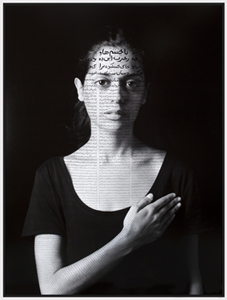
September 12 - November 17, 2012 |
SHIRIN NESHAT
|
THE BOOK OF KINGS
|
galerie jerome de noirmont
|

Roja, 2012. The Book of Kings series. Ink on LE silver gelatin print. 152,4 x 114,3 cm - 60 x 45 in.
exhibition release
A Persian Vision...
For her fourth solo exhibition at the gallery from September 12 to November 17, 2012, Shirin Neshat will present her latest works: the new video Overruled (2012) and the new photographic series The Book of Kings (2012).
Overruled is a shortened film version of the theatrical performance she directed with Shoja Azari in November 2011 in New York as part of the Performa 11 Festival. The Book of Kings features black and white portraits covered with calligraphic texts and drawings, divided into three groups representing the Masses, the Patriots, the Villains.
The merit and significance of literature and poetry are well known.
While poetry can be an invaluable tool for enhancing public life,
it can also be deceptive and harmful.
Poetry must be educational and constructive.
Our careful analysis has proven the subversive and illicit nature of these poems.
These words taken from the video Overruled are a good illustration of the timeless dimension of these new works by the Iranian artist. They are at once contemporary, in reaction to the recent events of the Arab Spring and the Iranian Green movement of 2009, and historic with the video depicting the trial of a poet tried for blasphemy by a judge and jury of patriots, similar to the one of Mansur Al-Hallaj in the 10thin century.
The narrative starts in a courtroom where an apparently banal trial is taking place. It evolves into profound philosophical arguments derailing the underpinning of theocratic laws, and ends with the triumphant victory of art and imagination. Viewed both as a story of contemporary Iran under of political and religious despotic rule or as the re-transcription of the historic trial of the Persian poet Mansur Al-Hallaj condemned for heresy in 922 AD, Overruled is a work rich in metaphors that explores the underlying conditions of power in socio-cultural structures.
The title of the new photographic work, The Book of Kings, which gives its name to the exhibition, also stems from this temporal and historical ambiguity. The title is actually taken directly from the Shahnameh ("Book of Kings"), a long and mythical Persian poem written by the poet Ferdowsi between the years 977 and 1010. In 60,000 verses, it narrates the history of Iran from the creation of the world until the Islamic conquest of Persia in the 7th century.
Three distinct groups make up this series of photographs:
- the Masses are featured by some 45 black and white head shot portraits of Iranian men and women’s faces, facing us with a neutral expression. A delicate calligraphy covers these portraits.
- the Patriots are head-and-shoulder portraits of young Iranian men and women facing front with one hand symbolically laid on the heart. Their faces and sometimes their arms are covered with delicately hand-written calligraphic poems taken from contemporary poetry written by Iranian authors.
- the Villains are represented by full-size portraits of men, seated or standing, whose face, arms and torso are naked and covered of drawings, epic scenes taken from Shahnameh. The artist emphasized their dramatic dimension by redrawing them in black ink and by introducing red, the only color used.
Again in this series, Shirin Neshat uses calligraphy as a way to emphasize the metaphorical value of her portraits. By darkening or, conversely, brightening the facial expressions of the subjects and their emotional intensity, the delicate calligraphic writings and drawings create an intimate link between the current energy of contemporary Iran (represented by the subjects of these portraits) and its historical and mythical past (as it appears in the Shahnameh).
By applying calligraphy on the faces and bodies and using very pronounced black and white contrasts, this new work of Shirin Neshat instinctively reminds us of her first world-famous series Women of Allah. However, as Abdee Kalantari points out in the catalog essay accompanying the exhibition, it is immediately distinguished by the delicacy and small, almost illegible size of the calligraphic writings, and especially by the absence of any obvious religious symbolism. Here in fact, the artist wants to take us into a dimension that is no longer that of the immediate, but of a historical perspective, more universal, beyond all present divisions.
Since its debut, the work of Shirin Neshat confronts these visible paradoxes that form the male and female, youth and old age, past and present, power and submission, black and white, light and darkness, joy and distress. Before, it was clear-cut and well illustrated as in the video Turbulent, which earned the artist the International Prize at the Venice Biennale in 1999. This confrontation is now expressed in a voluntarily more vague way, in response to the complexity of the current socio-politico-religious situation in Iran and in the Muslim world, as the result of a long and complicated history.
Now more than ever, the strength of Shirin Neshat’s art is not in the immediate impact of shocking images as in her first video and photo works, but in the ever growing lyricism of its concepts and its images. Fixed or filmed, with no other effects than calligraphy, these images take all their strength of expression in their metaphorical richness.









